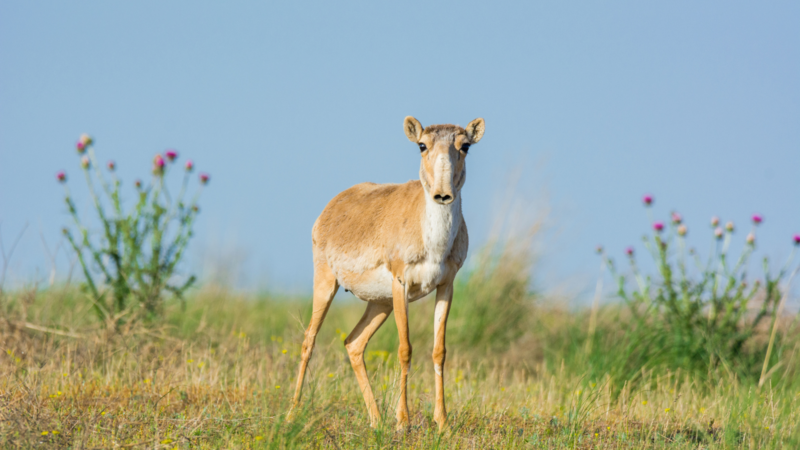The IUCN Red List status of saiga antelope (Saiga tatarica) has improved from Critically Endangered to Near Threatened, thanks to effective national and international conservation efforts. This substantial positive change in status – a rarity in conservation – reflects the remarkable recovery of saiga populations in Kazakhstan, which have risen from a perilous low of just 48,000 in 2005 to now over 1.9 million. Professor Dame E.J. Milner Gulland of the Department of Biology, who is also Co-Founder and Chair of the Saiga Conservation Alliance, explains:
“This brilliant news is the culmination of decades of collaborative work by national and international level organisations across the whole saiga range, including governments, NGOs, and academics. It shows how conservation can be effective if all parties work together, with a strong mission and appropriate resourcing.
It’s been the greatest privilege and honour for me to work alongside so many passionate conservationists over the years; the work is not finished, because there are still many threats that need to be addressed if the saiga is to recover and thrive across its whole range. But I am confident that we can get to a future in which the saiga has regained its rightful place within its ecosystems, as a component both of the natural world and the region’s culture and livelihoods.”
Saiga antelopes have roamed the earth since the last Ice Age, outliving iconic extinct species like woolly mammoths and sabre-toothed tigers, and play a crucial ecosystem role as a selective grazer, influencing vegetation structures and, in turn, supporting biodiversity across its habitat. Despite once migrating through eastern Europe, Asia, and Alaska, they are only currently found in fragmented populations across Eurasia, within Kazakhstan, Mongolia, the Russian Federation and Uzbekistan. There were an estimated 1 million saigas in Russia and Central Asia in the early 1990s, but by 2003 their numbers had plummeted, with only 6% of the population remaining.
International collaboration* has been critical to this recovery success, with partners including the Government of Kazakhstan and civil society actors collaborating to implement anti-poaching measures, protect and improve available habitat, and monitor existing populations. Working with local communities has also been critical, to raise their awareness of the issues facing the species and to form community-led ranger teams.
The change in status shows that measures are working, however conservation action is still urgently needed to ensure that saiga have a long-term sustainable future in Kazakhstan, and to ensure that populations recover in Mongolia, the Russian Federation, and Uzbekistan.
The species will only be fully recovered if it regains its role in the ecosystem across its entire range, with ongoing poaching, disease, climate change, disturbance, and infrastructure development all posing threats. Their new Near Threatened category reflects the potential for saiga’s status to deteriorate rapidly in the absence of ongoing conservation action – however, there is clear hope, with the conservation community committed to supporting this iconic species.

Getty Images
To read more about this work, please see the Saiga Conservation Alliance: http://saiga-conservation.org/2023/12/11/saiga-antelope-a-conservation-triumph-and-ongoing-challenges/
*Partners include Kazakh and other range state governments, Saiga Conservation Alliance, the Altyn Dala Conservation Initiative (comprising the Government of Kazakhstan, the Association for the Conservation of Biodiversity of Kazakhstan [ACBK], Fauna & Flora, Frankfurt Zoological Society, and the RSPB), NABU, the Wildlife Conservation Society, and WWF-Mongolia. They have been supported by the Convention on the Conservation of Migratory Species of Wild Animals (CMS) and the Convention on International Trade in Endangered Species of Wild Fauna and Flora (CITES).